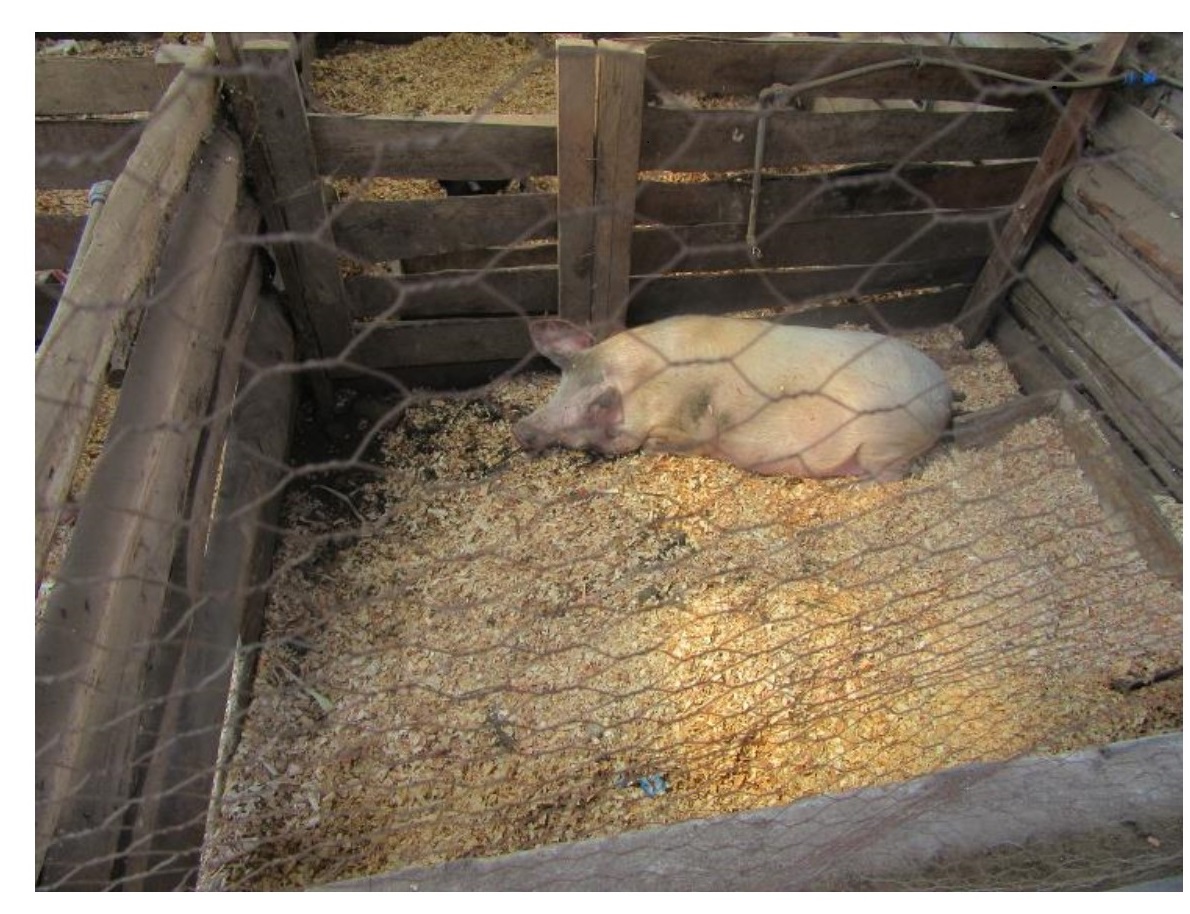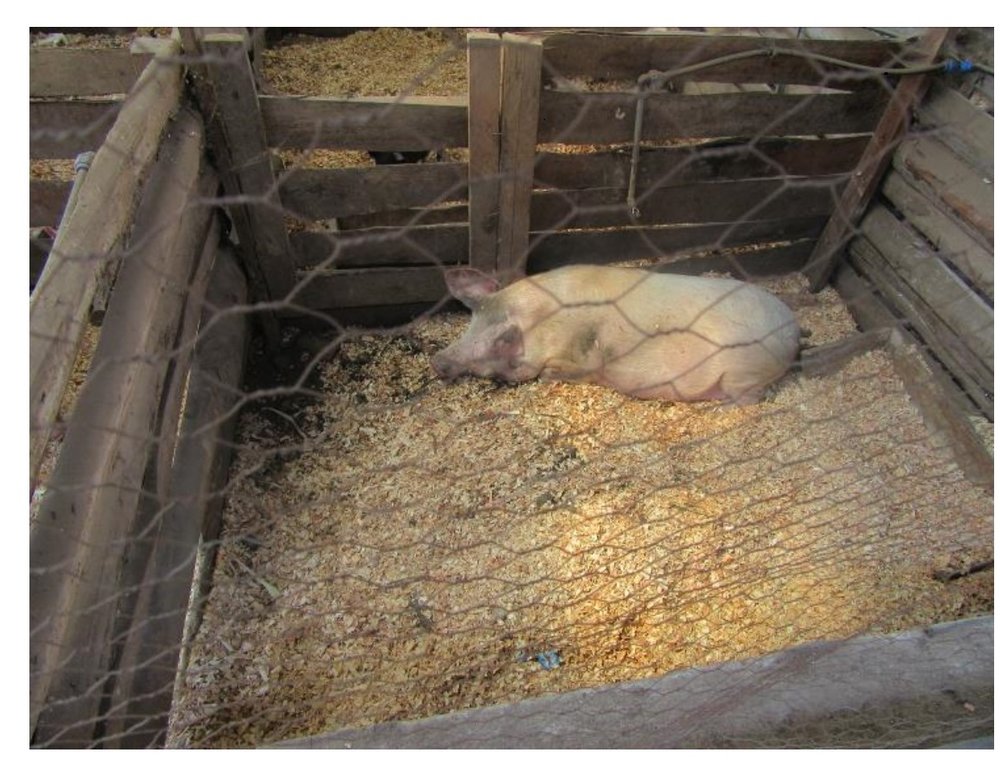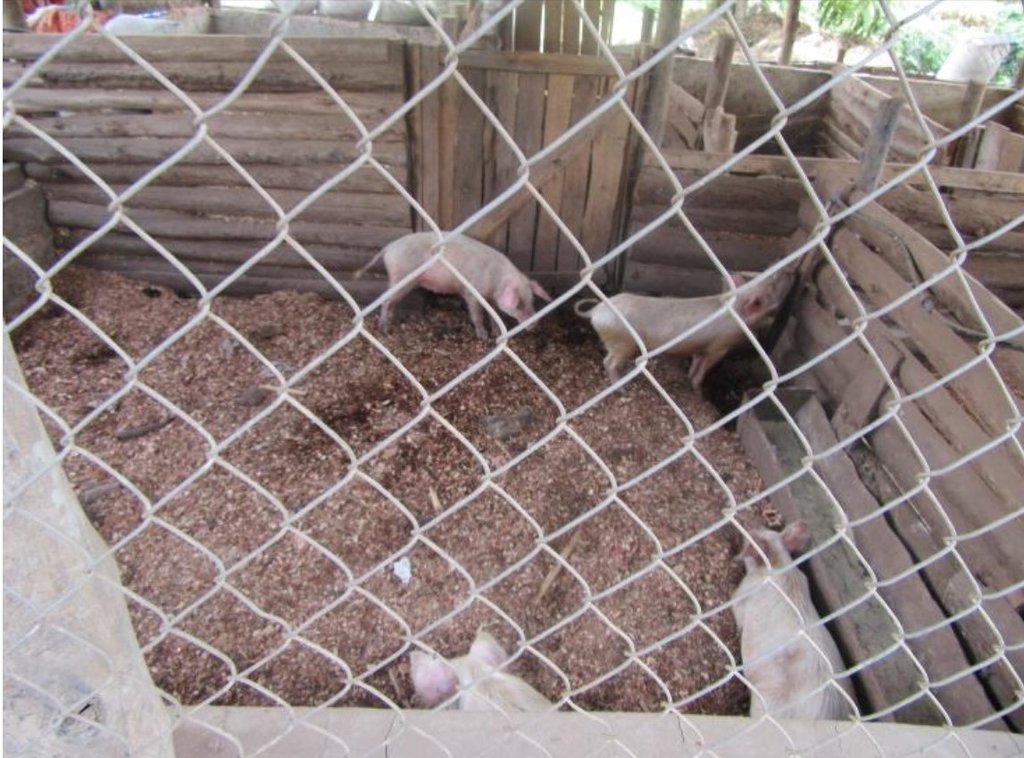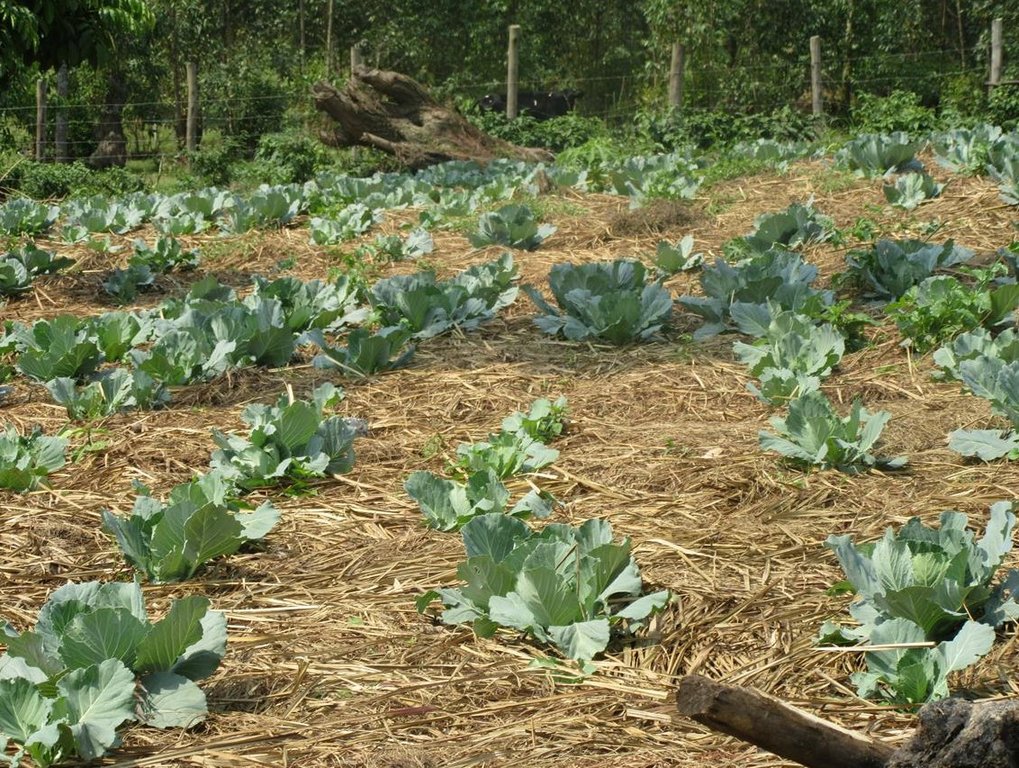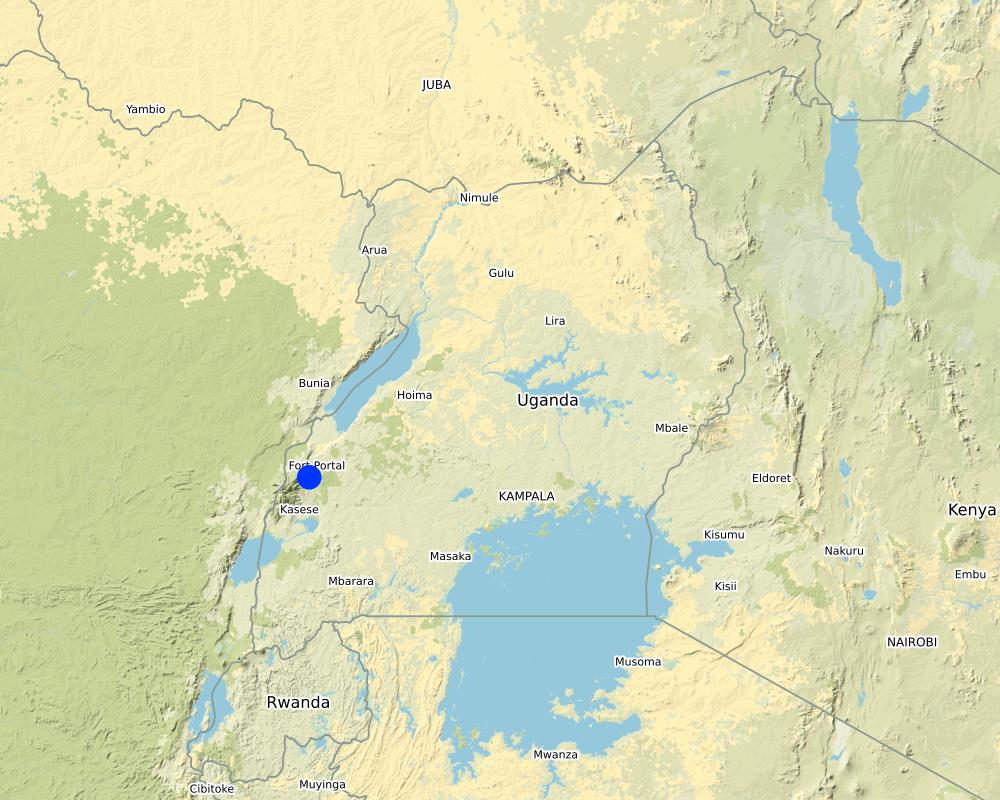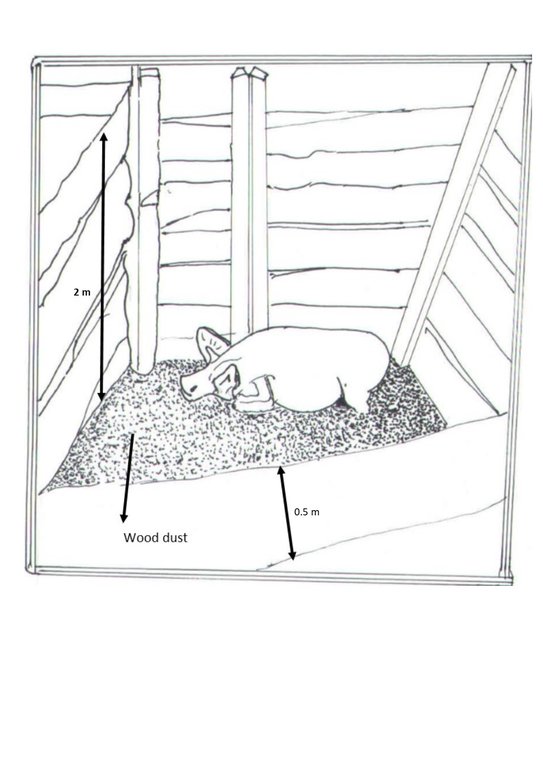Indigenous Micro Organism (IMO) use in Natural Pig Farming [乌干达]
- 创建:
- 更新:
- 编制者: JOSELINE KASHAGAMA
- 编辑者: Kamugisha Rick Nelson
- 审查者: Nicole Harari, Udo Höggel, Donia Mühlematter
Epunu
technologies_3366 - 乌干达
查看章节
全部展开 全部收起1. 一般信息
1.2 参与该技术评估和文件编制的资源人员和机构的联系方式
关键资源人
土地使用者:
Mujuruzi Benjamin
+256 775 392532 / +256 702 560904
Kegra Green Africa Farm (Kegra Farm)
P.O BOX 186 Keirere Village Bushenyi District - Uganda
乌干达
有助于对技术进行记录/评估的项目名称(如相关)
Scaling-up SLM practices by smallholder farmers (IFAD)有助于对技术进行记录/评估的机构名称(如相关)
National Agricultural Research Organisation (NARO) - 乌干达1.3 关于使用通过WOCAT记录的数据的条件
(现场)数据是什么时候汇编的?:
24/01/2018
编制者和关键资源人员接受有关使用通过WOCAT记录数据的条件。:
是
1.4 所述技术的可持续性声明
这里所描述的技术在土地退化方面是否存在问题,导致无法被认为是一种可持续的土地管理技术?:
否
2. SLM技术的说明
2.1 技术简介
技术定义:
Indigenous Micro Organisms (IMO) are homemade microbe mixtures which foster rapid anaerobic digestion of waste to create and maintain a healthy deep bed litter flooring leaving behind a fertilizer rich material whilst ensure no smells or flies. The microbe mixtures are produced by fermenting natural plants with sugar.
2.2 技术的详细说明
说明:
Natural pig farming is a non-polluting system of raising healthy pigs that uses the Indigenous Micro Organisms (IMO) in the sty’s deep bed litter floor to rapidly decompose pig waste.
Indigenous Micro Organisms (IMO) is a homemade microbe mixture that fosters rapid anaerobic digestion of waste. It is produced by fermenting plant materials like sweet potatoes or rice with sugar.
Piggery is a profitable enterprise but there is a belief that pigs are dirty animals. But if they are well looked after, they are clean farm animals. The use of Indigenous Micro - Organisms (IMO) in piggery creates and maintains an aesthetic and sanitized deep bed litter floor. The micro-organisms in the IMO mixture help in breaking down and convert the fecal matter rapidly into an unharmful product leaving the farmer with a rich fertilizer material whilst ensuring an odorless environment that attracts no flies. Many pig keepers are now adopting the use of IMO to improve piggery.
The IMO is applied to wood dust and the micro-organisms digest the cellulose in wood dust. The bedding including the IMO is frequently turned to mix it with the pig excrete. The IMO solution is sprayed to the bedding once a week which ensures a high level of micro-organism activity thus keeping the bedding healthy and free from smell.
The following are the materials needed to make IMO:
-sweet potatoes
-sugar
-water
-mineral lick (crude salt)
-saucepan
-a 100-litre container
The IMO production process requires boiling 20kg of sweet potatoes with crude salt (200g) until the potatoes are well cooked. The cooked potatoes are mashed into a paste, placed into a polythene bag and buried in the ground, about two 5cm deep, in a shaded area, preferably under trees to protect it from direct sunlight. The mixture is buried for 1 week. After this period, the mixture is unearthed and for every 2kg of it 500g of sugar are added and mixed. The mixture is kept in a plastic bucket and left to stand for another full week. After this time, the mixture would have changed color to black without a smell. To multiply the mixture, add 1kg of IMO to 200 ltrs of water and keep for two days. You may add some brown sugar to make the multiplication process quick. After 2 days the solution is ready for use.
The advantages of the IMO are that the pigs’ excrements become odorless, clean and dry that you literally don’t even have to clean it out. The micro-organisms in the wood dust help in breaking down fecal matter rapidly, leading to the elimination of odor. The inputs are made from natural materials, which are not only safe for the environment, but actually invigorate and rehabilitate the ecology. In terms of disease control the conditions inside the sty do not favor survival of disease causing pathogens due to the presence of IMOs which literally feed on the pathogens. The system is non-labour intensive as sties don’t require daily, weekly or even monthly mucking out. Production of high quality organic fertilizer as the decomposed litter will be removed from the sty after 9 months and used as manure. This manure is rich in IMO and is useful in improving the soil health than chemical fertilizers.
The disadvantages of the technology are that the sweetness of the IMO solution attracts the pigs to lick the wood dust which can led to the ingestion of the bedding material including endoparasite eggs. It is therefore, recommended that the farmer controls such potential infections through regular deworming of the animals.
2.3 技术照片
2.4 技术视频
日期:
24/1/2018
位置:
Bushenyi District, South Western Uganda
摄影师的名字:
Joseline Kashagama
2.5 已应用该技术的、本评估所涵盖的国家/地区/地点
国家:
乌干达
区域/州/省:
Western Uganda
有关地点的进一步说明:
Keirere Village, Bushenyi Town Council ,Nyakabirizi Sub county
注释:
Geo Coordinates (00.53345, 030.19235)
Map
×2.6 实施日期
注明实施年份:
2016
2.7 技术介绍
详细说明该技术是如何引入的:
- 通过项目/外部干预
注释(项目类型等):
The land user was introduced to the technology through a study tour to the United States of America
3. SLM技术的分类
3.1 该技术的主要目的
- 改良生产
- 创造有益的经济影响
- Control disease out break, source of organic manure
3.2 应用该技术的当前土地利用类型

农田
- 一年一作
- 乔木与灌木的种植
主要农作物(经济作物及粮食作物):
Cabbages, Passion fruits, Coffee

牧场
粗放式放牧场:
- 经营牧场
集约放牧/饲料生产:
- 收割和携带/零放牧
主要动物种类及产品:
Pigs (Large white and Hampshire breeds)
3.3 有关土地利用的更多信息
该技术所应用土地的供水:
- 混合雨水灌溉
注释:
The farmland has a swamp which is the main source of water
每年的生长季节数:
- 2
具体说明:
Two rainy seasons
牲畜密度(如相关):
200 pigs per 0.5 acre
3.4 该技术所属的SLM组
- 农畜综合管理
- 土壤肥力综合管理
- 废物管理/废水管理
3.5 技术传播
具体说明该技术的分布:
- 适用于特定场所/集中在较小区域
注释:
The pigs are confined in the stalls and the other land is used for cropping.
3.6 包含该技术的可持续土地管理措施

农艺措施
- A2:有机质/土壤肥力

结构措施
- S8:卫生/废水结构物
- S9:动植物庇护所

管理措施
- M2:改变管理/强度级别
- M6:废物管理(回收、再利用或减少)
3.7 该技术强调的主要土地退化类型

化学性土壤退化
- Cn:肥力下降和有机质含量下降(非侵蚀所致)

生物性退化
- Bl:土壤寿命损失
- Bp:害虫/疾病增加,捕食者减少
注释:
Bp: micro-organisms help break down fecal matter rapidly leaving a fertilizer rich material whilst ensure no smells or flies. They produce various materials such as anti-biotic substances, enzymes and lactic acids which suppress various diseases and promote chemical reaction in the soil.
3.8 防止、减少或恢复土地退化
具体数量名该技术与土地退化有关的目标:
- 防止土地退化
注释:
The decomposed litter is used as manure (Organic fertilizer). The manure is rich in Indigenous Micro Organisms and is useful in improving the soil health.
4. 技术规范、实施活动、投入和成本
4.1 该技术的技术图纸
4.2 技术规范/技术图纸说明
The sty is 50 m by 40 m and 1.5 m deep below the ground. Materials needed to construct included bricks to build the wall up to 1.2 meters high, wooden poles, roofing sheets (some transparent), welded wire mesh for the upper potion to allow proper ventilation. The floor is covered with wood dust to a depth of about 0.5 m, mixed with IMO solution while tapped water provided.
4.3 有关投入和成本计算的一般信息
具体说明成本和投入是如何计算的:
- 每个技术单元
指定单位:
Piggery Unit
具体说明成本计算所用货币:
- 美元
注明美元与当地货币的汇率(如相关):1美元=:
3600.0
注明雇用劳工的每日平均工资成本:
1.389
4.4 技术建立活动
| 活动 | 措施类型 | 时间 | |
|---|---|---|---|
| 1. | Plan and make the budget | 管理 | Monthly |
| 2. | Purchase of the IMO ingredients | 管理 | Monthly |
| 3. | Prepare the mixture | 管理 | Monthly |
| 4. | Storage of the mixture | 管理 | Monthly |
4.5 技术建立所需要的费用和投入
如果可能,按下表分列技术建立费用,并列明各项投入和每项投入的费用。如果您无法分解成本,给出建立该技术的总成本估算。:
159.12
| 对投入进行具体说明 | 单位 | 数量 | 单位成本 | 每项投入的总成本 | 土地使用者承担的成本% | |
|---|---|---|---|---|---|---|
| 劳动力 | Labour | Wage | 1.0 | 111.1 | 111.1 | 100.0 |
| 设备 | Potatoes | Kg | 20.0 | 0.417 | 8.34 | 100.0 |
| 设备 | Water | Litres | 400.0 | 0.028 | 11.2 | 100.0 |
| 设备 | Sauce pan | piece | 1.0 | 8.33 | 8.33 | 100.0 |
| 设备 | Sugar | kg | 5.0 | 0.972 | 4.86 | 100.0 |
| 设备 | Salt | kg | 2.5 | 0.56 | 1.4 | 100.0 |
| 设备 | 100 Litre Contianer / drum | piece | 1.0 | 13.89 | 13.89 | 100.0 |
| 技术建立所需总成本 | 159.12 | |||||
注释:
The land user bore all the costs. Some of the costs are bore only at the initial establishment of the technology thus the costs vary with time
4.6 维护/经常性活动
| 活动 | 措施类型 | 时间/频率 | |
|---|---|---|---|
| 1. | Changing of wood shavings / dust | 管理 | After 9 months |
| 2. | Turning of wood shavings / dust | 管理 | Everyday |
| 3. | Provision of feeds | 管理 | Everyday |
4.7 维护/经常性活动所需要的费用和投入(每年)
如果可能,按下表分解技术维护费用,并列明各项投入和每项投入的费用。如果您无法分解成本,给出维护该技术的总成本估算。:
1509.66
| 对投入进行具体说明 | 单位 | 数量 | 单位成本 | 每项投入的总成本 | 土地使用者承担的成本% | |
|---|---|---|---|---|---|---|
| 劳动力 | Labour | Month | 12.0 | 111.1 | 1333.2 | 100.0 |
| 设备 | Wood shavings / dust | Bags | 200.0 | 0.139 | 27.8 | 100.0 |
| 设备 | Sweet potatoes | kg | 12.0 | 0.417 | 5.0 | 100.0 |
| 肥料和杀菌剂 | Mineral licks | Kg | 100.0 | 0.278 | 27.8 | 100.0 |
| 肥料和杀菌剂 | Feeds | Kg | 100.0 | 0.19 | 19.0 | 100.0 |
| 肥料和杀菌剂 | Sugar | kg | 30.0 | 0.97 | 29.1 | 100.0 |
| 肥料和杀菌剂 | Salt | kg | 10.0 | 0.056 | 0.56 | 100.0 |
| 肥料和杀菌剂 | Water | Litres | 2400.0 | 0.028 | 67.2 | 100.0 |
| 技术维护所需总成本 | 1509.66 | |||||
注释:
The maintenance costs have been calculated on the annual basis. The price of water has been estimated since the land user uses free water piped from the swamp.
4.8 影响成本的最重要因素
描述影响成本的最决定性因素:
Initial pig sty establishment costs and regular deworming costs.
5. 自然和人文环境
5.1 气候
年降雨量
- < 250毫米
- 251-500毫米
- 501-750毫米
- 751-1,000毫米
- 1,001-1,500毫米
- 1,501-2,000毫米
- 2,001-3,000毫米
- 3,001-4,000毫米
- > 4,000毫米
指定年平均降雨量(若已知),单位为mm:
1233.00
有关降雨的规范/注释:
The driest month is July with 35 mm of rain. The greatest amount of precipitation occurs in November with an average of 154 mm.
注明所考虑的参考气象站名称:
Bushenyi District Local Government Report 2018. (https://www.bushenyi.go.ug/lg/population-culture)
农业气候带
- 潮湿的
5.2 地形
平均坡度:
- 水平(0-2%)
- 缓降(3-5%)
- 平缓(6-10%)
- 滚坡(11-15%)
- 崎岖(16-30%)
- 陡峭(31-60%)
- 非常陡峭(>60%)
地形:
- 高原/平原
- 山脊
- 山坡
- 山地斜坡
- 麓坡
- 谷底
垂直分布带:
- 0-100 m a.s.l.
- 101-500 m a.s.l.
- 501-1,000 m a.s.l.
- 1,001-1,500 m a.s.l.
- 1,501-2,000 m a.s.l.
- 2,001-2,500 m a.s.l.
- 2,501-3,000 m a.s.l.
- 3,001-4,000 m a.s.l.
- > 4,000 m a.s.l.
说明该技术是否专门应用于:
- 不相关
关于地形的注释和进一步规范:
Bushenyi district is a low lying plateau with undulating hills.
5.3 土壤
平均土层深度:
- 非常浅(0-20厘米)
- 浅(21-50厘米)
- 中等深度(51-80厘米)
- 深(81-120厘米)
- 非常深(> 120厘米)
土壤质地(表土):
- 中粒(壤土、粉土)
土壤质地(地表以下> 20厘米):
- 中粒(壤土、粉土)
表土有机质:
- 中(1-3%)
5.4 水资源可用性和质量
地下水位表:
表面上
地表水的可用性:
好
水质(未处理):
仅供农业使用(灌溉)
水的盐度有问题吗?:
否
该区域正在发生洪水吗?:
否
关于水质和水量的注释和进一步规范:
Water quality is sometimes affected by the run off water that collects in the swamp.
5.5 生物多样性
物种多样性:
- 低
栖息地多样性:
- 低
5.6 应用该技术的土地使用者的特征
定栖或游牧:
- 定栖的
生产系统的市场定位:
- 商业/市场
非农收入:
- > 收入的50%
相对财富水平:
- 平均水平
个人或集体:
- 个人/家庭
机械化水平:
- 手工作业
性别:
- 男人
土地使用者的年龄:
- 中年人
5.7 应用该技术的土地使用者拥有或租用的平均土地面积
- < 0.5 公顷
- 0.5-1 公顷
- 1-2 公顷
- 2-5公顷
- 5-15公顷
- 15-50公顷
- 50-100公顷
- 100-500公顷
- 500-1,000公顷
- 1,000-10,000公顷
- > 10,000公顷
这被认为是小规模、中规模还是大规模的(参照当地实际情况)?:
- 小规模的
5.8 土地所有权、土地使用权和水使用权
土地所有权:
- 个人,有命名
土地使用权:
- 个人
用水权:
- 个人
5.9 进入服务和基础设施的通道
健康:
- 贫瘠
- 适度的
- 好
教育:
- 贫瘠
- 适度的
- 好
技术援助:
- 贫瘠
- 适度的
- 好
就业(例如非农):
- 贫瘠
- 适度的
- 好
市场:
- 贫瘠
- 适度的
- 好
能源:
- 贫瘠
- 适度的
- 好
道路和交通:
- 贫瘠
- 适度的
- 好
饮用水和卫生设施:
- 贫瘠
- 适度的
- 好
金融服务:
- 贫瘠
- 适度的
- 好
6. 影响和结论性说明
6.1 该技术的现场影响
社会经济效应
生产
作物生产
注释/具体说明:
Micro-organisms help break down fecal matter rapidly leaving a fertilizer rich material which improves crop production.
作物质量
饲料生产
饲料质量
畜牧生产
SLM之前的数量:
Less weight
SLM之后的数量:
More weight gain
注释/具体说明:
The micro organisms in the IMO solution rapidly break down the fecal matter into environmental friendly matter rather than wet slurry which promotes bad smell and flies hence controlled pests and disease attacks
生产故障风险
注释/具体说明:
Indigenous Micro Organisms are a source of organic manure that improves the soil health.
土地管理
水资源可用性和质量
家畜用水的可用性
注释/具体说明:
Rain water is harvested from the animal shed and stored in the reservoir.
收入和成本
农业投入费用
注释/具体说明:
Reduced feed costs and labour since there's no regular cleaning of the sty and only one permanent worker is employed at the farm to feed the pigs.
农业收入
注释/具体说明:
Reduced maintenance costs and high piggery productivity.
收入来源的多样性
注释/具体说明:
Incomes from sale of the organic manure and crops.
经济差异
注释/具体说明:
Increased incomes.
工作量
SLM之前的数量:
3 full time labourers
SLM之后的数量:
1 full time labourer
注释/具体说明:
Less since there's no regular cleaning of the sty and only one permanent worker is employed at the farm to feed the pigs.
社会文化影响
食品安全/自给自足
注释/具体说明:
Increased pigs and crop production.
土地使用权/用水权
注释/具体说明:
Improved land use since more land has been put into use for piggery and crop production (Coffee, seedling bed and Cabbages).
娱乐机会
注释/具体说明:
The farm is being used for agricultural related study tours.
社区机构
注释/具体说明:
Community Institutions come for study tours regarding piggery and IMO use.
国家机构
注释/具体说明:
Local Government institutions bring farmers for study tours at the Farm.
SLM/土地退化知识
注释/具体说明:
Land use and environmental study tours
生态影响
土壤
土壤堆积
注释/具体说明:
Use of organic manure
养分循环/补给
注释/具体说明:
Use of organic manure
6.2 该技术的场外影响已经显现
地下水/河流污染
注释/具体说明:
Non-polluting litter disposal.
对邻近农田的破坏
注释/具体说明:
The pigs are paddocked.
6.4 成本效益分析
技术收益与技术建立成本相比如何(从土地使用者的角度看)?
短期回报:
消极
长期回报:
非常积极
技术收益与技术维护成本/经常性成本相比如何(从土地使用者的角度看)?
短期回报:
积极
长期回报:
非常积极
注释:
The establishment costs are very high compared to the benefits gained in the short run but the benefits increase over time.
6.5 技术采用
- 1-10%
如若可行,进行量化(住户数量和/或覆盖面积):
10 households in the village.
在所有采用这项技术的人当中,有多少人是自发地采用该技术,即未获得任何物质奖励/付款?:
- 90-100%
注释:
Private initiatives.
6.6 适应
最近是否对该技术进行了修改以适应不断变化的条件?:
否
6.7 该技术的优点/长处/机会
| 土地使用者眼中的长处/优势/机会 |
|---|
| It's a clean system of piggery using IMOs which create a healthy environment since it eliminates bad smell. |
| The wood dust can cheaply be obtained locally. |
| 编制者或其他关键资源人员认为的长处/优势/机会 |
|---|
| The technology is environmentally friendly as it does not produce bad smell which is common in normal piggery enterprises. |
| The technology is not labour demanding since only one full time labourer is employed. |
| The saw dust once removed from the sty is used as manure which improves the soil health hence increases crop production. |
6.8 技术的弱点/缺点/风险及其克服方法
| 土地使用者认为的弱点/缺点/风险 | 如何克服它们? |
|---|---|
| The technology is relatively expensive to establish |
| 编制者或其他关键资源人员认为的弱点/缺点/风险 | 如何克服它们? |
|---|---|
| High initial costs to start the technology | Once established, it can be used for a very long time |
7. 参考和链接
7.1 信息的方法/来源
- 实地考察、实地调查
3
- 与土地使用者的访谈
3
- 根据报告和其他现有文档进行编译
4
7.3 链接到网络上可用的相关信息
URL:
https://www.scribd.com/doc/54536534/Organic-Piggery-in-Uganda-IMO
标题/说明:
Natural Pig farming
URL:
https://www.naturalpigfarming.com/microorganismuse.htm
URL:
https://insteading.com/blog/indigenous-microorganisms-imo/
标题/说明:
Bushenyi District Local Government
URL:
https://www.bushenyi.go.ug/lg/population-culture
链接和模块
全部展开 全部收起链接
无链接
模块
无模块


